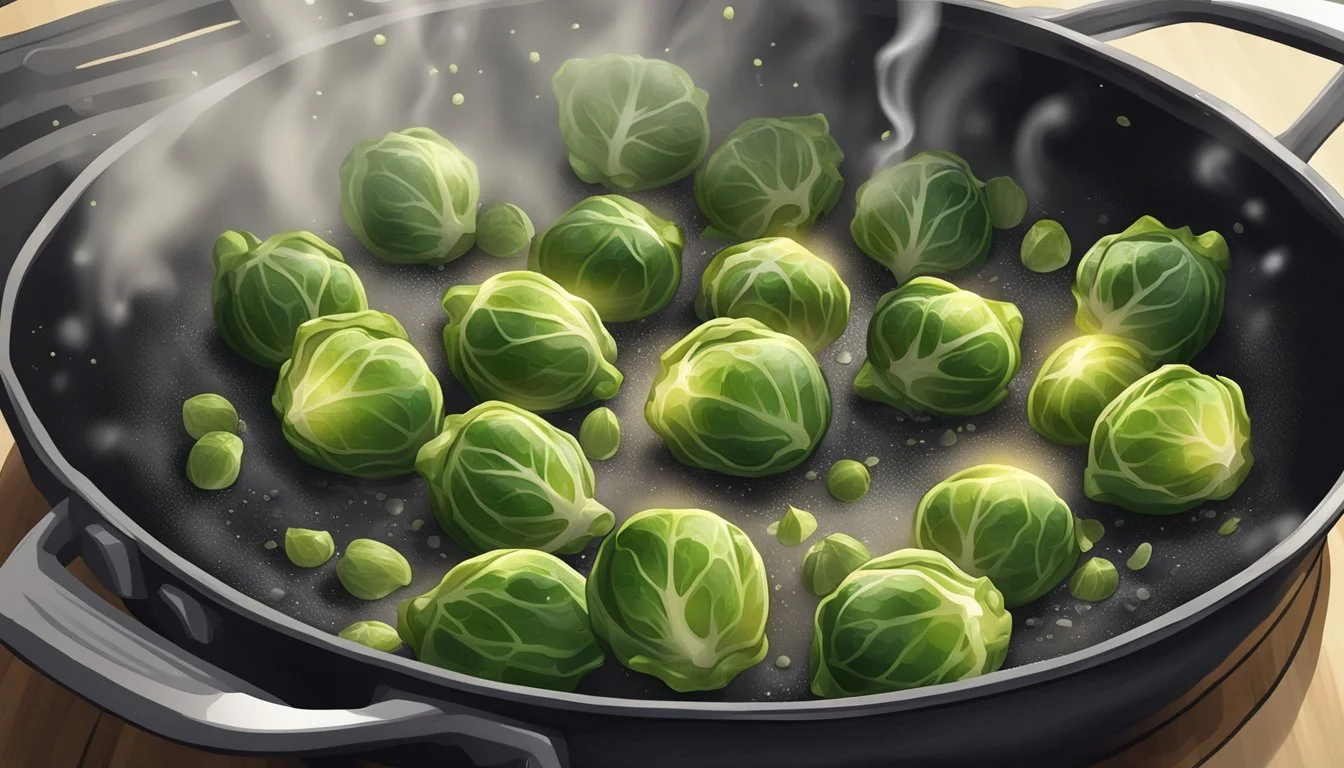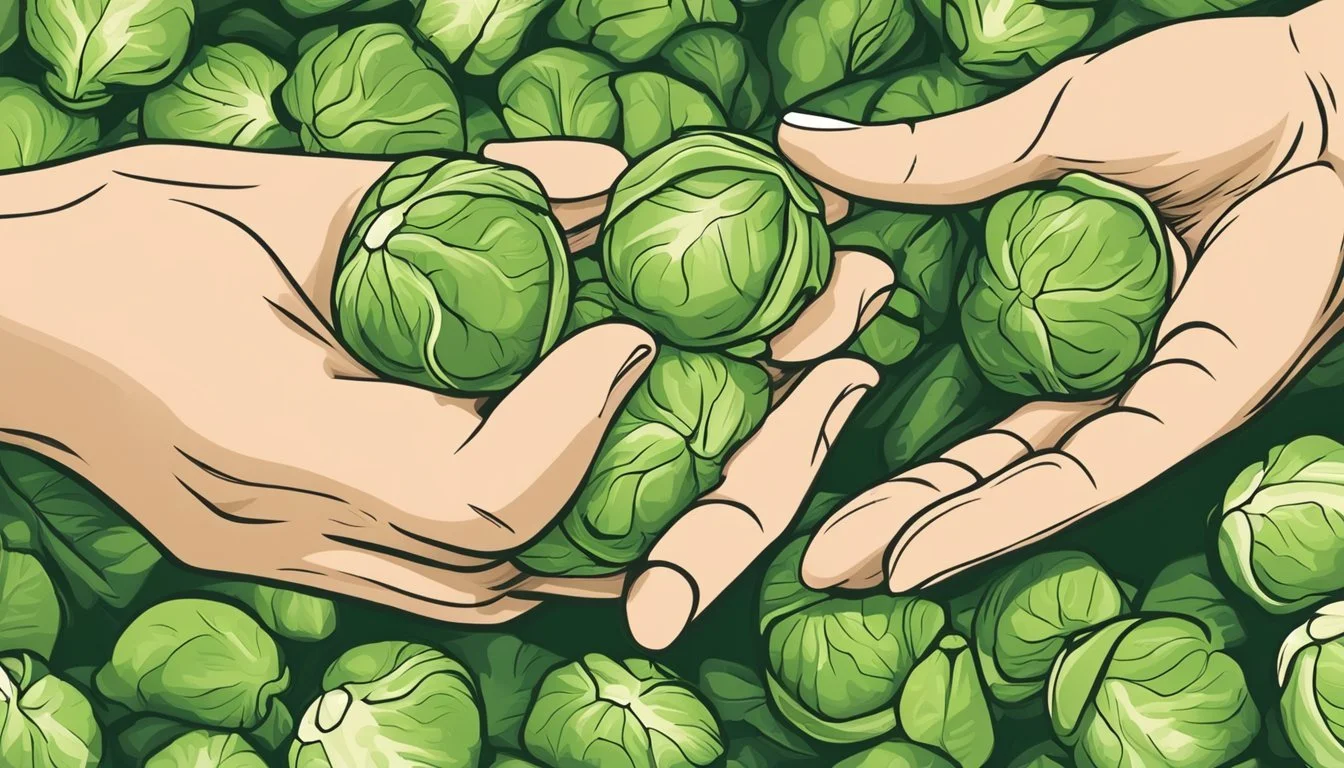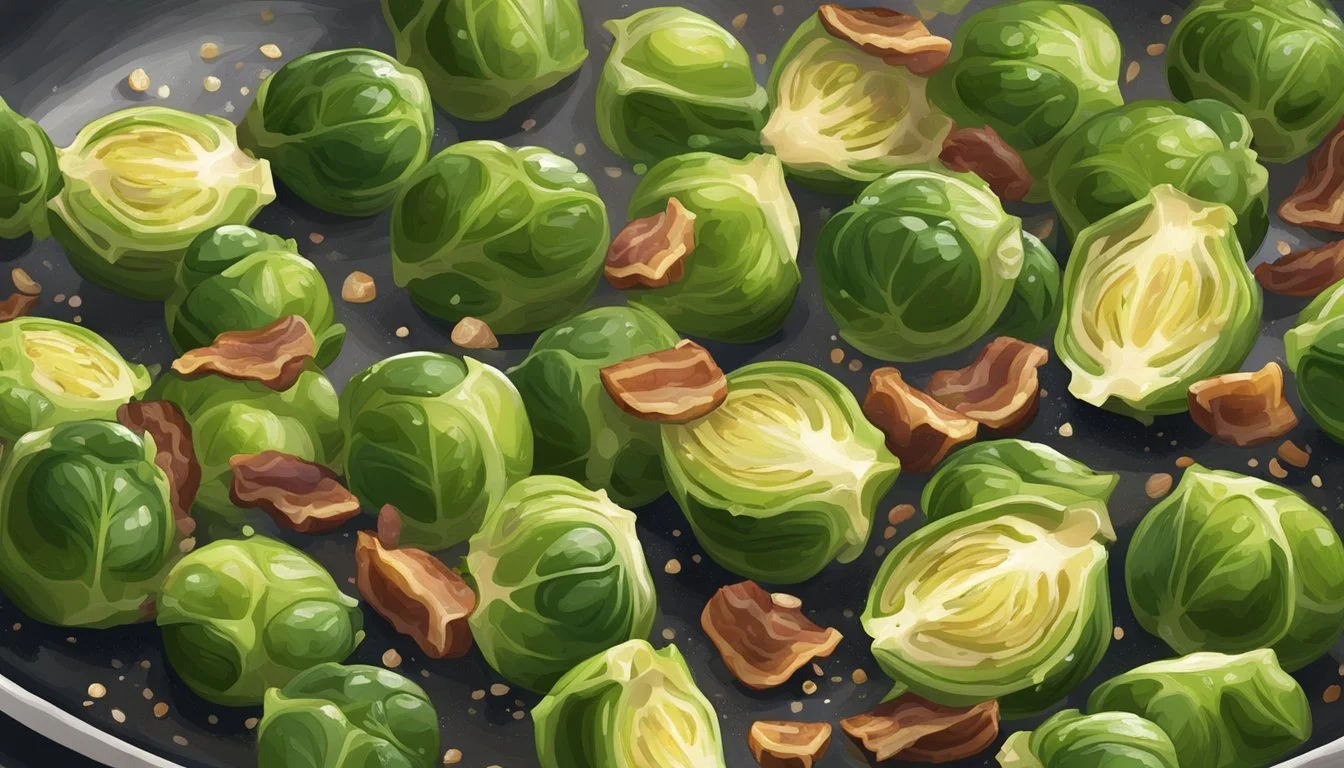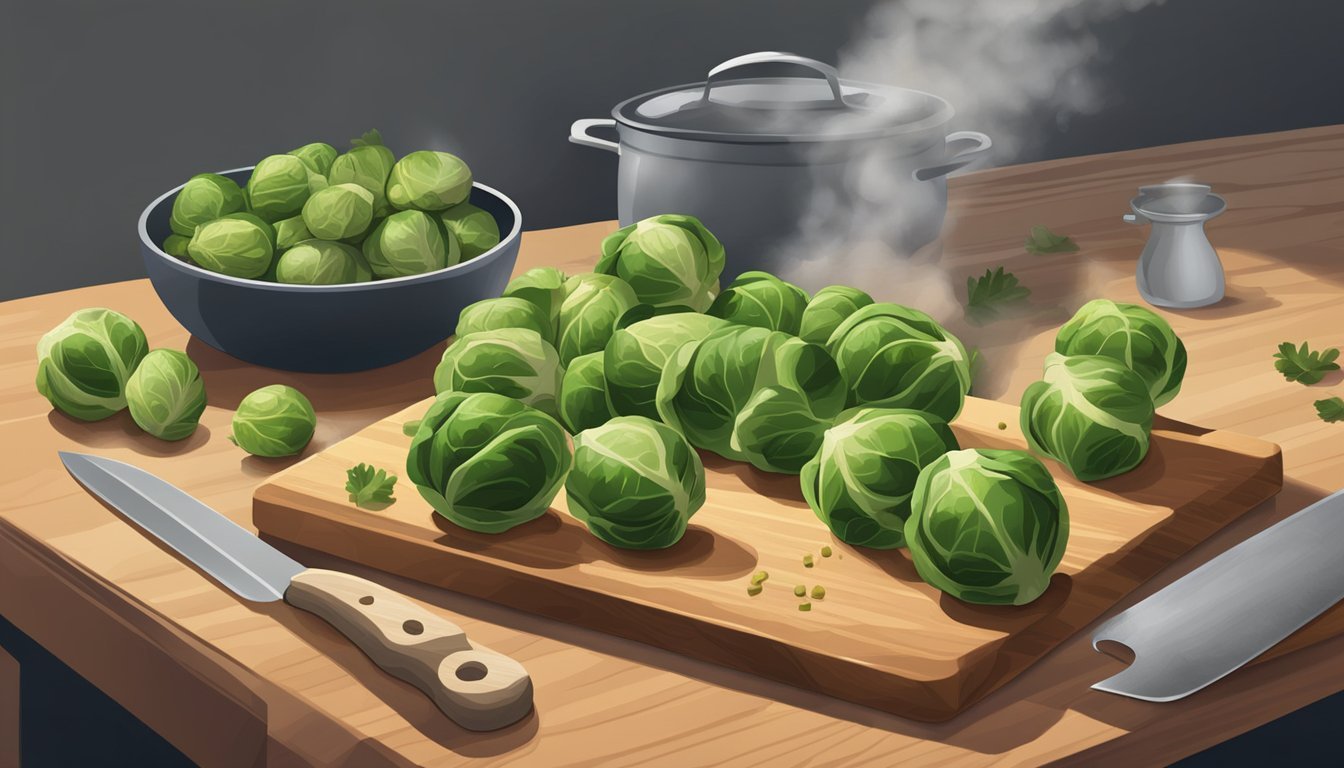How to Cook Brussels Sprouts
Delicious and Crispy Results
Brussels sprouts, those miniature cabbage-like vegetables, often get a bad rap. Yet when prepared properly, they can be a delicious and nutritious addition to any meal. Roasting, sautéing, and steaming are popular methods that bring out the best flavors and textures in Brussels sprouts.
These versatile veggies can be transformed with simple ingredients like olive oil, salt, and balsamic vinegar. Roasting Brussels sprouts in the oven creates crispy, caramelized edges and tender interiors. For a quicker option, sautéing them in a skillet yields a crisp-tender texture with charred bits that add depth of flavor.
Experimenting with different cooking techniques and seasonings can turn even the most ardent Brussels sprouts skeptic into a fan. From honey-balsamic glazes to crispy bacon additions, there are countless ways to elevate this humble vegetable into a crave-worthy side dish.
Selecting Quality Brussels Sprouts
Choosing fresh, high-quality Brussels sprouts is essential for delicious results. Look for firm, compact heads with vibrant green color and tightly closed leaves.
Identifying Freshness
Fresh Brussels sprouts should feel heavy for their size and have a bright green color. Avoid sprouts with yellowing leaves, brown spots, or loose outer leaves. The cut ends should appear fresh, not dry or discolored. Smaller sprouts tend to be sweeter and more tender.
Smell the sprouts - they should have a mild, slightly cabbage-like aroma. Strong or unpleasant odors indicate the sprouts are past their prime. Check for any signs of mold or decay, especially between the leaves.
For optimal freshness, choose Brussels sprouts still attached to the stalk when possible. These will stay fresh longer than loose sprouts.
Brussels Sprouts Varieties
Several Brussels sprouts varieties offer different flavors and characteristics. Common types include:
Jade Cross: Compact plants with uniform, medium-sized sprouts
Long Island Improved: Large plants producing many small, tender sprouts
Diablo: Heat-tolerant variety with flavorful, tightly packed sprouts
Falstaff: Purple-red sprouts with a slightly nutty taste
Some newer hybrid varieties have been bred for improved sweetness and milder flavor. These may appeal to those who find traditional Brussels sprouts too bitter.
When selecting, consider how you plan to prepare the sprouts. Smaller varieties work well for roasting whole, while larger sprouts are ideal for halving or shredding.
Preparation Essentials
Proper preparation is key to achieving delicious Brussels sprouts. A few simple techniques can elevate the flavor and texture of this nutritious vegetable.
Cleaning and Cutting Techniques
Start by rinsing Brussels sprouts under cold water to remove dirt. Trim off the stem ends and discard any yellowed or damaged outer leaves. For even cooking, cut larger sprouts in half lengthwise through the stem.
A sharp knife and sturdy cutting board are essential tools. To prevent rolling, place sprouts cut-side down. For smaller sprouts, leave them whole or quarter larger ones for faster cooking.
Some chefs recommend cutting an "X" in the core to help steam penetrate. This can be especially useful when boiling or steaming.
Pre-Boiling and Blending Flavors
Pre-boiling Brussels sprouts for 2-3 minutes can reduce bitterness and ensure even cooking. After boiling, immediately plunge them into ice water to stop the cooking process and preserve their bright green color.
Salt the water when pre-boiling to enhance flavor. A pinch of baking soda in the water can help maintain color and texture.
For added depth, consider tossing cut sprouts with olive oil, salt, and pepper before roasting. A splash of acid, like lemon juice or balsamic vinegar, can brighten the flavor profile.
Experiment with complementary seasonings such as garlic, shallots, or herbs. These additions can transform Brussels sprouts into a standout dish.
Cooking Techniques Overview
Brussels sprouts can be prepared using various methods to achieve different textures and flavors. Each technique brings out unique characteristics in this versatile vegetable.
Roasting for Crispy Texture
Roasting Brussels sprouts creates a crispy exterior and caramelized flavor. Preheat the oven to 400°F (200°C). Trim and halve the sprouts, then toss with olive oil, salt, and pepper.
Spread them on a baking sheet, cut-side down. Roast for 20-25 minutes, shaking the pan halfway through. The high temperature allows the edges to crisp up nicely.
For extra flavor, add garlic cloves or bacon bits before roasting. The result is golden-brown sprouts with a satisfying crunch and tender interior.
Sautéing for Golden Browns
Sautéed Brussels sprouts develop a beautiful golden-brown color and retain a slight crispness. Heat olive oil or butter in a large skillet over medium-high heat.
Add halved sprouts cut-side down and cook for 5-7 minutes without stirring. This allows them to caramelize. Flip and cook for an additional 3-5 minutes.
Season with salt, pepper, and optional garlic or lemon juice. Sautéing is quick and preserves the sprouts' natural sweetness while creating a delicious sear.
Steaming for Crisp-Tender Results
Steaming Brussels sprouts maintains their vibrant color and nutrients while achieving a crisp-tender texture. Place a steamer basket in a pot with an inch of water.
Bring water to a boil, add trimmed sprouts to the basket, and cover. Steam for 5-7 minutes until tender but still bright green.
Season with salt, pepper, and a drizzle of olive oil or butter. Steaming is ideal for those who prefer a lighter, cleaner taste without added fats.
Grilling for Smoky Char
Grilling imparts a smoky flavor and attractive char marks to Brussels sprouts. Preheat the grill to medium-high heat. Toss halved sprouts with olive oil, salt, and pepper.
Place them cut-side down on the grill grates. Cook for 5-7 minutes, then flip and grill for another 5 minutes. The high heat creates a crispy exterior while maintaining a tender center.
For added flavor, brush with balsamic glaze or sprinkle with Parmesan cheese before serving. Grilling adds a unique dimension to the sprouts' taste profile.
Using an Air Fryer for Healthier Options
Air frying Brussels sprouts offers a healthier alternative to deep frying while still achieving a crispy texture. Preheat the air fryer to 375°F (190°C).
Toss trimmed and halved sprouts with a light coating of olive oil, salt, and pepper. Place them in the air fryer basket in a single layer.
Cook for 10-12 minutes, shaking the basket halfway through. The circulating hot air creates a crispy exterior without excess oil. This method is perfect for those seeking a lighter yet flavorful option.
Flavor Enhancements
Brussels sprouts can be transformed from bland to delicious with the right flavor additions. Creative seasonings, sauces, and herbs elevate these nutritious vegetables into crave-worthy side dishes.
Seasoning Combinations
Salt and pepper form the foundation for seasoning Brussels sprouts. Kosher salt brings out their natural flavors, while freshly ground black pepper adds a subtle kick. Garlic powder or minced fresh garlic infuses the sprouts with savory notes.
For heat lovers, a pinch of red pepper flakes creates pleasant spiciness. Lemon zest brightens the flavor profile with citrusy aroma. A sprinkle of grated Parmesan cheese adds nutty, salty complexity.
Experiment with spice blends like za'atar, curry powder, or Italian seasoning for global-inspired flavors. Crushed nuts like walnuts or pecans provide crunch and earthy taste.
Sauces and Glazes
Drizzling sauces over cooked Brussels sprouts adds moisture and flavor. Balsamic glaze creates sweet-tart notes that complement the vegetable's slight bitterness. Honey mustard sauce offers tangy sweetness.
Lemon juice squeezed over hot sprouts brightens their taste. For richness, toss in melted butter or olive oil infused with garlic.
A maple syrup glaze caramelizes beautifully when roasting Brussels sprouts. Soy sauce adds umami depth. Sriracha or hot sauce provides spicy kick for adventurous palates.
Herbs and Spices
Fresh herbs elevate Brussels sprouts with aromatic flavors. Chopped dill pairs well with lemon for a light, refreshing combination. Thyme and rosemary impart earthy notes perfect for roasted sprouts.
Dried spices offer concentrated flavor. Smoked paprika adds depth and subtle heat. Cumin brings warm, nutty undertones. Cayenne pepper provides a fiery kick in small amounts.
Whole spices like caraway or fennel seeds offer bursts of flavor when toasted and sprinkled over cooked sprouts. Fresh ginger grated into stir-fried Brussels sprouts adds zesty warmth.
Accompaniments and Variations
Brussels sprouts pair wonderfully with a variety of ingredients and can be adapted to suit different dietary needs. Their versatility allows for creative combinations and flavorful additions.
Protein Pairings
Brussels sprouts complement many protein sources. Crispy bacon bits add a savory crunch, while diced pancetta introduces a rich, salty flavor. For a leaner option, grilled chicken breast pairs well with roasted sprouts.
Pork dishes, such as roasted tenderloin or chops, make excellent companions. The mild sweetness of pork balances the slightly bitter notes of the sprouts.
For seafood lovers, pan-seared salmon or scallops offer a delicate contrast to the hearty vegetable. These pairings create well-rounded, satisfying meals.
Vegetable Mixes
Combining Brussels sprouts with other vegetables enhances flavor and texture. Roasted root vegetables like carrots, parsnips, and sweet potatoes create a colorful medley.
Sautéed mushrooms add an earthy element. Try shiitake or oyster mushrooms for a gourmet touch. Caramelized onions bring sweetness and depth to the dish.
For a refreshing twist, try a shaved Brussels sprouts salad. Thinly slice raw sprouts and toss with crisp apples, dried cranberries, and a light vinaigrette.
Pine nuts or toasted almonds sprinkled over roasted sprouts add crunch and nutty flavor.
Vegan and Gluten-Free Adaptations
Brussels sprouts are naturally vegan and gluten-free, making them suitable for various dietary restrictions. For vegan dishes, replace bacon with smoky tempeh or coconut bacon.
Nutritional yeast provides a cheesy flavor without dairy. Toss roasted sprouts with garlic-infused olive oil and a sprinkle of nutritional yeast for a savory side dish.
Gluten-free pasta made from rice, corn, or quinoa can be combined with sautéed Brussels sprouts for a hearty meal. Add sun-dried tomatoes and herbs for extra flavor.
For a creamy vegan sauce, blend cashews with lemon juice and garlic. Drizzle over roasted sprouts for a rich, dairy-free option.
Recommended Recipes
Roasted Brussels Sprouts with Balsamic and Honey offers a delightful blend of flavors. Toss halved sprouts with olive oil, salt, and pepper. Roast at 425°F for 20 minutes, stirring halfway through. Drizzle with balsamic vinegar and honey before serving.
For a crispy twist, try Parmesan Roasted Brussels Sprouts. Coat halved sprouts with oil, garlic, salt, pepper, grated Parmesan, and breadcrumbs. Arrange cut-side down on a baking sheet and roast at 400°F for 30 minutes, flipping halfway.
Bacon Brussels Sprouts combine two crowd-pleasing ingredients. Cook chopped bacon until crisp, then set aside. Sauté halved sprouts in the bacon fat until caramelized. Toss with the crispy bacon before serving.
Honey-Mustard Brussels Sprouts Salad offers a fresh approach. Shred raw sprouts and toss with a dressing of honey, Dijon mustard, and apple cider vinegar. Add chopped apples, grapes, and walnuts for extra texture and flavor.
For a simple preparation, steam Brussels sprouts. Cut an "X" in the base of each sprout and steam for 9-11 minutes until tender. Season with salt and pepper to taste.
These recipes showcase the versatility of Brussels sprouts, from roasted to raw preparations. Experiment with different seasonings and cooking methods to find your favorite.
Post-Cooking Best Practices
Proper handling of cooked Brussels sprouts ensures maximum flavor and freshness. Storing leftovers correctly, employing effective freezing techniques, and reheating methods all contribute to maintaining the quality of this versatile vegetable.
Storing Leftovers
Store cooked Brussels sprouts in airtight containers in the refrigerator. They will keep for 3-4 days when properly refrigerated. For optimal freshness, cool the sprouts completely before storage.
Place a paper towel in the container to absorb excess moisture. This helps prevent sogginess and maintains texture. Label containers with the date to track freshness.
Avoid storing Brussels sprouts with strong-smelling foods, as they may absorb odors. Keep them separate from raw meats to prevent cross-contamination.
Freezing Techniques
Freeze cooked Brussels sprouts for longer-term storage. Spread cooled sprouts on a baking sheet and freeze until solid, about 1-2 hours. This prevents clumping.
Transfer frozen sprouts to freezer-safe bags or containers. Remove excess air to prevent freezer burn. Label with the date and use within 10-12 months for best quality.
Blanched Brussels sprouts also freeze well. Blanch for 3-5 minutes, cool in ice water, then freeze using the same method as cooked sprouts.
Reheating without Losing Flavor
Reheat Brussels sprouts carefully to maintain texture and flavor. For crispy results, use an oven or air fryer. Preheat to 350°F (175°C) and heat for 5-7 minutes.
Stovetop reheating works well for sautéed sprouts. Heat a pan over medium heat, add a small amount of oil, and cook for 3-4 minutes, stirring occasionally.
Avoid microwaving when possible, as it can make sprouts soggy. If necessary, microwave in short 30-second intervals, stirring between each. Add a splash of water to prevent drying.
For frozen sprouts, thaw in the refrigerator overnight before reheating. This ensures even warming and helps maintain texture.
Nutritional Insights
Brussels sprouts pack a powerful nutritional punch. These small, cabbage-like vegetables are low in calories but high in essential nutrients.
A cup of cooked Brussels sprouts contains only 56 calories, making them an excellent choice for weight management. They provide 4 grams of protein and 11 grams of carbohydrates.
Brussels sprouts are rich in fiber, supporting digestive health. They also offer an impressive array of vitamins and minerals:
Vitamin C: 85% of daily value
Vitamin K: 132% of daily value
Folate: 14% of daily value
Potassium: 7% of daily value
The high vitamin C content in Brussels sprouts boosts immune function and acts as a potent antioxidant. This helps protect cells from damage and supports overall health.
Brussels sprouts contain compounds that may have anticancer properties. These include sulforaphane, which is currently being studied for its potential health benefits.
The nutrient profile of Brussels sprouts makes them beneficial for heart health. Their fiber and antioxidant content may help reduce inflammation and support cardiovascular function.
For those following specific diets, Brussels sprouts are versatile. They're low in carbohydrates, fitting well into keto and low-carb eating plans.
Additional Cooking Tips
Trimming Brussels sprouts before cooking enhances their flavor and texture. Remove any discolored outer leaves and trim the stem end slightly.
For even cooking, choose sprouts of similar size or cut larger ones in half. This ensures all pieces cook at the same rate.
To reduce bitterness, try blanching Brussels sprouts briefly in boiling water before roasting or sautéing. This step can mellow their flavor.
Adding a touch of sweetness can balance the sprouts' natural bitterness. A drizzle of honey or maple syrup works well, especially when roasting.
For extra crispiness, roast Brussels sprouts at a high temperature (400-425°F) and arrange them cut-side down on the baking sheet.
Experiment with different seasonings to vary the flavor profile. Garlic, lemon zest, balsamic vinegar, and smoked paprika are excellent options.
To prevent overcooking, check Brussels sprouts frequently during the last few minutes of cooking. They should be tender but still have a slight bite.
Leftover cooked Brussels sprouts can be repurposed in salads, frittatas, or grain bowls for quick and easy meals.
Visual Guidance and Support
Visual aids enhance the Brussels sprouts cooking process. Step-by-step photos and video tutorials provide clear demonstrations of techniques and methods for preparing this versatile vegetable.
Step-by-Step Photos
High-quality images showcase each stage of Brussels sprouts preparation. Photos illustrate proper trimming techniques, displaying how to remove outer leaves and cut sprouts in half.
Subsequent images depict seasoning methods, showing measured amounts of oil, salt, and pepper being added to the vegetables. Photos also capture the ideal single-layer arrangement on a baking sheet.
Final images present the finished product, highlighting the golden-brown color and caramelized edges of perfectly roasted Brussels sprouts. These visual guides help cooks achieve consistent results.
Video Tutorials
Video content offers dynamic instruction for cooking Brussels sprouts. Tutorials cover various methods, including roasting, sautéing, and steaming.
Videos demonstrate proper knife skills for trimming and halving sprouts. They show real-time cooking processes, allowing viewers to observe color changes and doneness indicators.
Expert chefs provide tips on achieving ideal textures and flavors. Videos also showcase creative recipe variations, inspiring cooks to experiment with different seasonings and complementary ingredients.
These visual resources empower home cooks to master Brussels sprouts preparation with confidence and skill.





